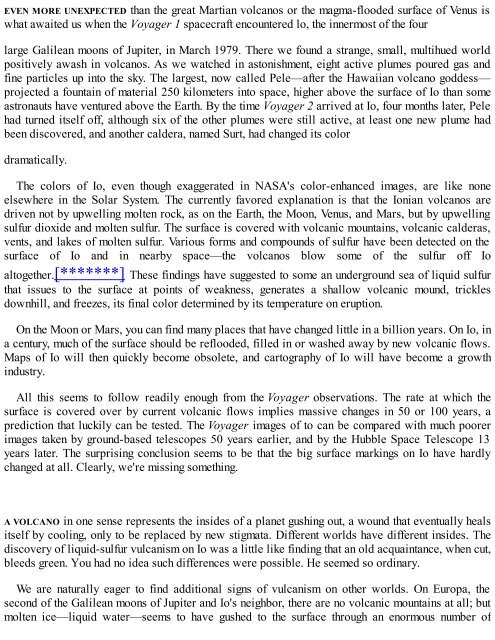Pale Blue Dot ( PDFDrive.com ) (1)
Create successful ePaper yourself
Turn your PDF publications into a flip-book with our unique Google optimized e-Paper software.
EVEN MORE UNEXPECTED than the great Martian volcanos or the magma-flooded surface of Venus is<br />
what awaited us when the Voyager 1 spacecraft encountered lo, the innermost of the four<br />
large Galilean moons of Jupiter, in March 1979. There we found a strange, small, multihued world<br />
positively awash in volcanos. As we watched in astonishment, eight active plumes poured gas and<br />
fine particles up into the sky. The largest, now called Pele—after the Hawaiian volcano goddess—<br />
projected a fountain of material 250 kilometers into space, higher above the surface of Io than some<br />
astronauts have ventured above the Earth. By the time Voyager 2 arrived at Io, four months later, Pele<br />
had turned itself off, although six of the other plumes were still active, at least one new plume had<br />
been discovered, and another caldera, named Surt, had changed its color<br />
dramatically.<br />
The colors of Io, even though exaggerated in NASA's color-enhanced images, are like none<br />
elsewhere in the Solar System. The currently favored explanation is that the Ionian volcanos are<br />
driven not by upwelling molten rock, as on the Earth, the Moon, Venus, and Mars, but by upwelling<br />
sulfur dioxide and molten sulfur. The surface is covered with volcanic mountains, volcanic calderas,<br />
vents, and lakes of molten sulfur. Various forms and <strong>com</strong>pounds of sulfur have been detected on the<br />
surface of Io and in nearby space—the volcanos blow some of the sulfur off Io<br />
altogether.[*******] These findings have suggested to some an underground sea of liquid sulfur<br />
that issues to the surface at points of weakness, generates a shallow volcanic mound, trickles<br />
downhill, and freezes, its final color determined by its temperature on eruption.<br />
On the Moon or Mars, you can find many places that have changed little in a billion years. On Io, in<br />
a century, much of the surface should be reflooded, filled in or washed away by new volcanic flows.<br />
Maps of Io will then quickly be<strong>com</strong>e obsolete, and cartography of Io will have be<strong>com</strong>e a growth<br />
industry.<br />
All this seems to follow readily enough from the Voyager observations. The rate at which the<br />
surface is covered over by current volcanic flows implies massive changes in 50 or 100 years, a<br />
prediction that luckily can be tested. The Voyager images of to can be <strong>com</strong>pared with much poorer<br />
images taken by ground-based telescopes 50 years earlier, and by the Hubble Space Telescope 13<br />
years later. The surprising conclusion seems to be that the big surface markings on Io have hardly<br />
changed at all. Clearly, we're missing something.<br />
A VOLCANO in one sense represents the insides of a planet gushing out, a wound that eventually heals<br />
itself by cooling, only to be replaced by new stigmata. Different worlds have different insides. The<br />
discovery of liquid-sulfur vulcanism on Io was a little like finding that an old acquaintance, when cut,<br />
bleeds green. You had no idea such differences were possible. He seemed so ordinary.<br />
We are naturally eager to find additional signs of vulcanism on other worlds. On Europa, the<br />
second of the Galilean moons of Jupiter and Io's neighbor, there are no volcanic mountains at all; but<br />
molten ice—liquid water—seems to have gushed to the surface through an enormous number of


